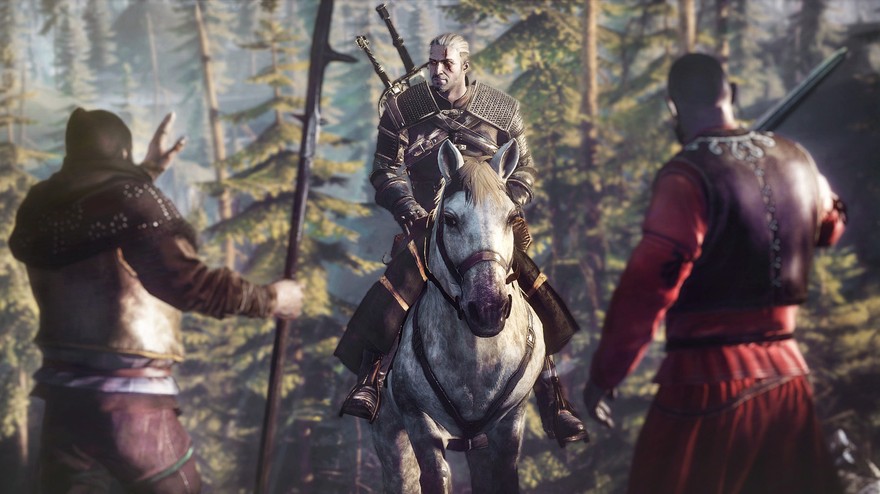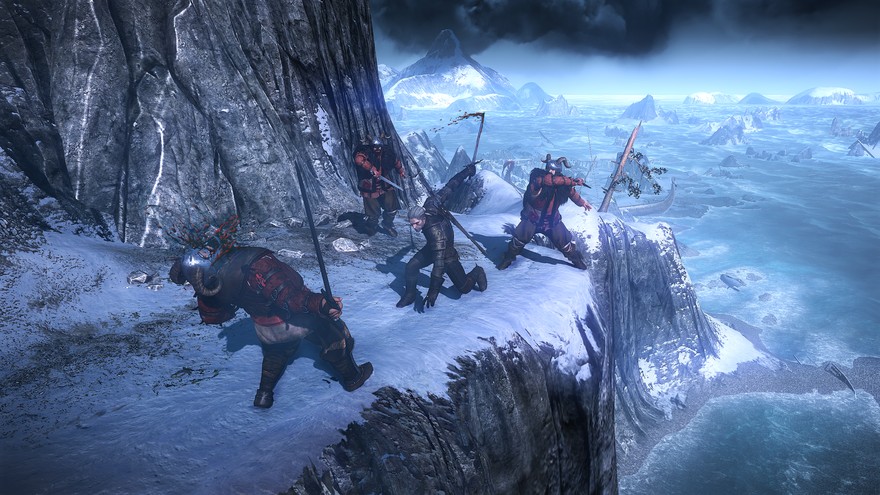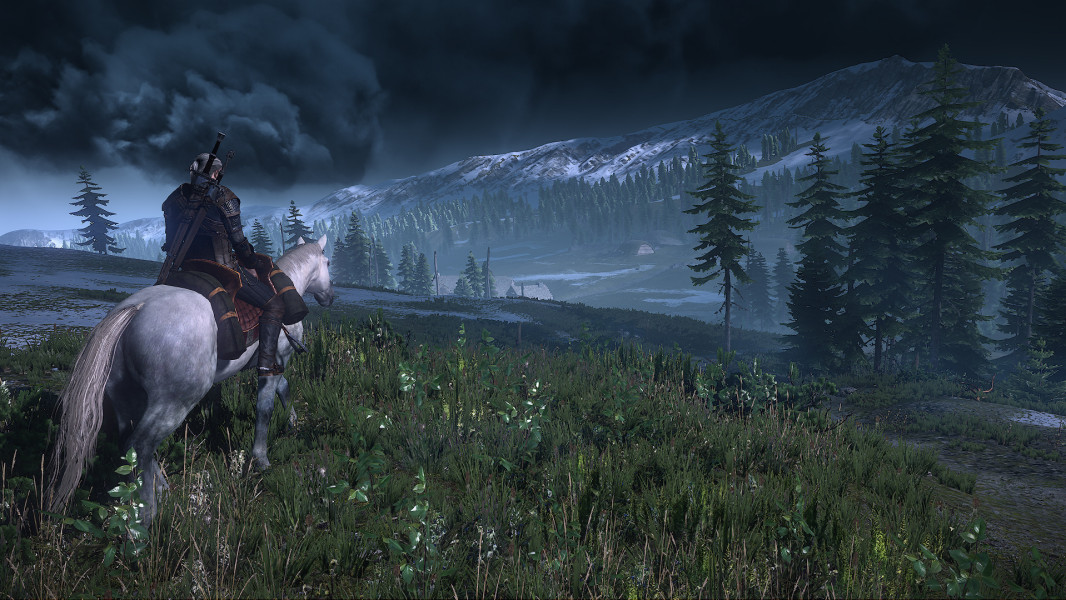Twenty something years ago, I peeled the plastic wrap off of Dragon Warrior IV. I loaded it into my Nintendo with the care I imagine an archaeologist would use to handle a fossilized triceratops egg. I plunged into the game’s varied 8-bit landscapes, multi-quest structure, and specialized characters. It made me dream of not just playing in an expansive and fantastical videogame world, but inhabiting one. To go where I wanted to go, pursue the quests I wanted to pursue, and smite my foes the way I wanted them smote.
Today, we have those games. A lot of them, and they keep expanding in scope. Bethesda’s The Elder Scrolls series used to take place in one province of Tamriel per title, but soon we’ll get to gallivant across the whole continent in TES Online. Based on the size of Grand Theft Auto V compared to previous installments, Rockstar’s next GTA game may string together multiple open-world metropolises around the globe, challenging us to hold together an international operation.
We are spoiled with open world riches, in other words. We expect not just a lot but more than we can reasonably even do. As Mateusz Tomaszkiewicz, the lead quest designer for CD Projekt RED’s upcoming The Witcher 3: Wild Hunt, put it, it’s not just a matter of “how to fill such a huge environment with content,” but making that massive amount of content unique. Every quest, for example, should feel engaging and consequential, not just another addition to a laundry list tasks that amount to “bring me this, bring me that, etcetera etcetera.”
That challenge presents distinct issues for CD Projekt RED. The Witcher 2: Assassins of Kings was thrilling in its scope, but it was still an action RPG. Its story branched and the sidequests were beautifully authored, creating a sort of bespoke rhythm to each player’s journey, but we each essentially did the same things, followed the same paths.
With The Witcher 3, CD Projekt RED’s developers look not just to put players into a massive multi-region open world, but to give them full freedom of choice within it. But that makes it even trickier, since that freedom of choice must be anchored not to a mutable avatar but to one man: Geralt of Rivia, the titular witcher.

A recent trailer illustrates the issue. Imagine you just slew a monster that makes Pennywise the clown from It seem like a solid choice to entertain at your nephew’s birthday party. Trudging through the swamp, you collect your fee for killing the monster from a shady type who’s about to hang a woman. Your gut says she’s innocent. Then again, you’ve seen far worse things in this world, so you ride on. Yet something nags at you. Do you stop and help, or do you keep on?
The whole thing is beautifully produced, and, indeed, looks like the sort of experience one would have in the earlier games. But is it possible for such a narrative to be emergent? Can The Witcher 3 make the open world game more than activities and collectibles?
Defamiliarizing the Increasingly Familiar
The more open-world games—and to some extent, fantasy action RPGs—continue crowding each other, the more they risk looking generic. Something like Dark Souls gets by on art direction and a singular design, but incredible polish wasn’t enough to save something like Kingdoms of Amalur.

On paper, The Witcher 3 appears at risk for recycling such too-familiar content. It draws on many of the same mythologies and cultural allusions as other open-world fantasy series, such as The Elder Scrolls and World of Warcraft. Elves and dwarves evoke Tolkien, and monster-slaying quests conjure Beowulf and King Arthur lore. Even the title of The Witcher 3: Wild Hunt alludes to European folklore and the tales of spectral huntsmen appearing in the wilds.
But The Witcher differentiates itself in the way it defamiliarizes these familiar constructs. For Mateusz and his team, that means fully embracing the “low fantasy” of the source material, Andrzej Sapkowski’s The Witcher book series.
This “low” fantasy draws a contrast to the high or epic variety, such as The Lord of the Rings, which takes place in a world intentionally realized to a point that it disconnects us from our own. These stories rest on epic conflicts between good and evil, where the fate of the world hangs in the balance. Low fantasy, and, by extension, The Witcher, repositions elements of fantasy in a world that closely resembles our own, one where the central conflict is more likely to center on, say, a king’s personal ambition rather than a giant evil eye floating in the sky.
Mateusz elaborated, using the elves as an example. “You accept, for example, that the elves are noble, they’re a very old race, everyone respects them, and so on, but he approached them in a completely different way.” In The Witcher games, we see the elves have a “darker side to [their] mortality, how that affects their society, how other races treat them.”
Sapkowski’s Witcher universe looks similar to our contemporary world, one rife with political machinations, jealousies, and gritty topics that sound lifted from a Chicago police blotter. Because the nature of these conflicts offers more potential for players to identify with the game world, there’s more potential they’ll care about shaping that world. A monster terrorizing a small town, for example, draws uncomfortable parallels to today’s newspaper headlines, such as the recent chemical spills in West Virginia crippling towns along the Elk River.
There’s plenty of room for epic mountaintop dragon-slaying in the world. But, as the trailer with the woman being hanged points out, the story is more interesting if those monsters echo real ones.
Character: Established or Build-Your-Own?
You could counter that CD Projekt RED’s developers have it easier because they’re drawing from an established source. Many elements of the story have already been decided.
But that ignores a few key things, such as the challenge of bringing a nonlinear experience to a story that’s already been told. This becomes doubly important to The Witcher because the designers must also honor an established character.

“When you have an established character like Geralt, you have always to think about what this character would do,” said Mateusz. That also extends to what he wouldn’t do: “He wouldn’t slaughter a village of innocent peasants.”
That means the developers have to honor the kinds of choice Geralt would make, but present these choices in a way that makes the player feel that they’re making a fresh decision with tangible consequences.
Mateusz related a quest in The Witcher 3 that sends players out to save a village from a monster called the Forest Spirit.
“Through the quest, you learn that if you kill this monster, that village will cease to have a symbiotic relationship with this monster. So you could appease this monster, or kill it as you’re supposed to do because you’re a monster slayer, which will have dire consequences for the village.”
Accepting this choice through the context of Geralt’s experience intensifies its cost. But it also appeals to players’ own sense of leadership: follow one’s own sense of duty, or make a decision for the benefit of people who likely will neither understand nor appreciate that decision?
And those decisions come with consequences, ones that don’t make themselves apparent until perhaps much later in the game. There are rumblings that The Witcher 3 will have more than 30 possible endings based on your choices.
Mateusz voiced no criticism of open-world games that use a build-your-own character format, sympathizing with the dilemmas other developers face. “It has to be able to be many different things, so you have to tailor the game with quests to cover all options that you can choose.”
Quantity vs. Quality
The increasing size of open-world games poses a paradox: more unique adventures means more stuff to forget. Nonlinear design doesn’t help this, as detouring into side quests can diminish the urgency of the main plot.
I argued with a friend about this in Skyrim. He thought the game was best enjoyed by completing the main plot as quickly as possible, so he could play the rest of the game with all the rewards that came from defeating Alduin. That seemed like nonsense to me. Why would I give up the richest part of the storyline so quickly? To go on side quests with a few better shouts? No thanks.

Mateusz anticipated that dilemma. “It’s still extremely important for us that the player will have this feeling that the main storyline is still complex, it’s still mature, it’s deep,” he said. “It’s easy to forget what you’re doing a few hours ago in the main quest.”
Given examples such as the Forest Spirit quest, it seems Mateusz hopes to put players through decision-making scenarios with both short-term and long-term consequences. The Witcher 2 did this some to great effect. In chapter one, players must choose between helping Iorveth or Roche. One choice results in a feast, the other a massacre. Another choice to help Iorveth or Roche immediately follows, and this choice results in different versions of chapter two.
Players can probably expect The Witcher 3 to be filled with choices that always return them to one question: what kind of world do you hope to live in later?
“We’re still aiming for something where you as the player feel as though you’re influencing the game world,” said Mateusz.
Aside from artistic and storytelling concerns, the vastness of open-world games also poses plenty of problems for programmers. Bugs in Skyrim are legion, especially those that impacted the storytelling. I’m still smarting from when the Jarl of Winterhold sent me not once, but twice to recover the Helm of Winterhold, and the game’s radiant questing put the helm in a location tied to another (and more interesting) quest in my journal. The result? I waited 30 in-game days before I could resume the more compelling quest. The denizens of Winterhold seemed none the wiser, but I knew. I knew.
Commonality of Features
Alchemy, crafting, collecting raw materials … I can’t remember the first game I played that introduced these, but all have become ubiquitous in some form to open-world games. That makes me wonder: how do developers make these distinct? What makes drinking a potion in The Witcher a distinct experience from drinking a potion in Skyrim?
For Mateusz, it’s about returning the focus to making players think through the consequences.
“It’s not like in most games [where] you’re low on health, so you drink [a health potion], and then you’re fine and you can carry on,” he said.
In The Witcher universe, potions usually last minutes, not seconds, and they’re highly toxic. This feeds into The Witcher 3’s promise for dynamic, tactical combat. Players must think ahead because the potions’ building toxicity limits how many can be taken. Limited resources makes tactical planning essential. There’s no luxury to pull up the item menu and down a bunch of potions to recover from an ill-conceived strategy; the immediate moment remains paramount when squaring up against a grotesque flying thing with human-like torso or some kind of unholy union of a deer and troll. The diversity of these monsters points toward to changing strengths and weaknesses.
That’s significant because The Witcher keeps Geralt’s abilities in a smaller sphere as opposed to the larger, more buffet-style character-development systems in other open-world games, as we see MMOs’ classes, Skyrim’s skill trees or Fallout’s SPECIAL ruleset. Geralt can’t specialize and become the world’s most powerful mage or most slithery assassin. He is most powerful when he is most versatile, but he’s still always Geralt.
Geralt’s perhaps comparatively smaller skill set builds in a highly detailed track. As before, he independently draws and sheaths his one steel and one silver sword (one for humans, one for monsters). He coats them with enhanced blade oils. He throws bombs and drops traps. He casts a small assortment of magical signs that are powerful when intelligently integrated with his other abilities. It’s how creatively players string all these abilities together that makes Geralt so formidable.

As the player bores into this particularized set of abilities, the controls become finely tuned; the detail of the systems becomes a new language, not very much at all like all those other action RPGs the game ostensibly recalls. Does it ever become too much? Is there a point when what CD Projekt Red has done to distinguish the game combines with the intricacy of the world, when it all becomes more of a burden than a showcase?
I asked Mateusz. He laughed. “I don’t think there is, to be honest.”
The Witcher 2’s complexity, it could be argued, benefitted from the straightforward structure of a more traditional RPG. But even with the skepticism about The Witcher 3’s jump to an open world, that skepticism is at least equalled by the excitement to see how it turns out. It looks, after all, beautiful. If CD Projekt RED nails it, The Witcher 3 could finally prove that in an open world, bigger can actually be better.
